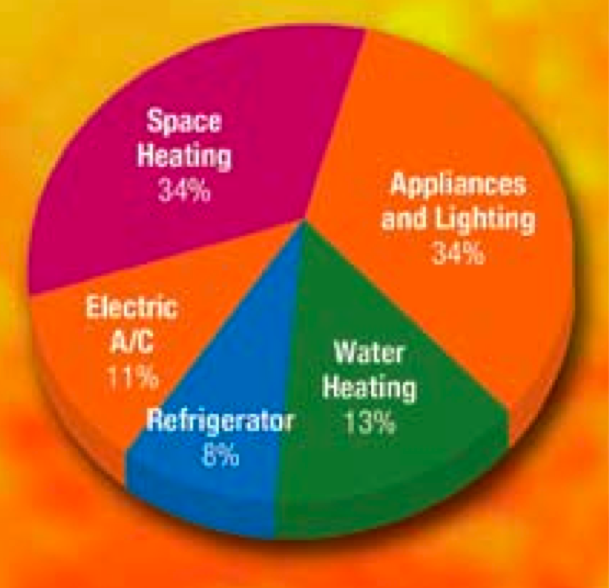| 1. |
Which of these following tips truly effect in saving the energy? |
|
|
Use compact fluorescent light bulbs |
|
|
Turn off your computer and monitor when not in use. |
|
|
Wash only full loads of dishes and clothes. |
|
|
Air dry dishes instead of using your dishwasher’s drying cycle. |
|
|
All of the above |
| 2. |
Plug home electronics, such as TVs and DVD players, into power strips; turn the power strips off when the equipment is not in use (TVs and DVDs in standby mode still use several watts of power). |
|
|
True |
|
|
False |
| 3. |
Set your thermostat comfortably low in the winter and comfortably high in the summer. Install a programmable thermostat that is compatible with your heating and cooling system. This would save your Energy effectively. |
|
|
True |
|
|
False |
| 4. |
Look for the ENERGY STAR label on home appliances and products. ENERGY STAR products meet strict efficiency guidelines set by the U.S. Environmental Protection Agency and the U.S. Department of Energy. |
|
|
True |
|
|
False |
| 5. |
Ventilation plays a large role in providing moisture control and reducing summer cooling bills. Attic vents can be installed along the entire ceiling cavity to help ensure proper airflow from the soffit to the attic to make a home more comfortable and energy efficient. |
|
|
True |
|
|
False |
| 6. |
One of the most cost-effective ways to make your home more comfortable year-round is to add insulation to your attic. |
|
|
True |
|
|
False |
| 7. |
What does the figure 1.0 illustrate about?  Figure 1.0 Figure 1.0 |
|
|
How do we use energy in our homes. |
|
|
How to save energy effectively. |
|
|
How to earn money. |
|
|
None of the above. |
| 8. |
Check for holes or cracks around your walls, ceilings, windows, doors, light and plumbing fixtures, switches, and electrical outlets that can leak air into or out of your home. This type of act does not help you in saving money. |
|
|
True |
|
|
False. |
| 9. |
Areas that leak air into and out of your home cost you lots of money. List the sources for air-leaks? |
|
|
Plumbing and utility access |
|
|
Attic entrance |
|
|
Electrical outlets and switches |
|
|
Water and furnace flues |
|
|
All of the above |
| 10. |
By combining proper equipment maintenance and upgrades with appropriate insulation, air sealing, and thermostat settings, you can cut your energy use for heating and cooling, and reduce environmental emissions, from 20% to 50%. |
|
|
True |
|
|
False |
| 11. |
Heating and cooling your home uses more energy and drains more energy dollars than any other system in your home. Typically, 45% of your utility bill goes for heating and cooling. |
|
|
True |
|
|
False |
| 12. |
Heat pumps are the most efficient form of electric heating in moderate climates, providing three times more heating than the equivalent amount of energy they consume in electricity. |
|
|
True |
|
|
False |
| 13. |
You can lose up to 60% of your heated air before it reaches the register if your ducts aren’t insulated and they travel through unheated spaces such as the attic or crawlspace. |
|
|
True |
|
|
False |
| 14. |
If you use your conventional fireplace while your central heating system is on, what tips can help reduce energy losses? |
|
|
If you never use your fireplace, plug and seal the chimney flue. |
|
|
Check the seal on the flue damper and make it as snug as possible. |
|
|
Use grates made of C-shaped metal tubes to draw cool room air into the fireplace and circulate warm air back into the room. |
|
|
All of the above |
| 15. |
Installing new, high-performance windows will improve your home’s energy performance. While it may take many years for new windows to pay off in energy savings, the benefits of added comfort and improved aesthetics and functionality may make the investment worth it to you. |
|
|
True |
|
|
False |
|
|
All of the above. |
| 16. |
Compact fluorescent bulbs are four times more energy efficient than incandescent bulbs and provide the same light levels. |
|
|
True |
|
|
False |
| 17. |
Refrigerators with the freezer on the side are more efficient than those with freezers on the top. |
|
|
True |
|
|
False |
| 18. |
ENERGY STAR does not label clothes dryers because most of them use similar amounts of energy, which means there is little difference in energy use between models. |
|
|
True |
|
|
False |
| 19. |
To maximize savings with a laptop, put the AC adapter on a power strip that can be turned off (or will turn off automatically); the transformer in the AC adapter draws power continuously, even when the laptop is not plugged into the adapter. |
|
|
True |
|
|
False |
| 20. |
Studies have shown that using rechargeable batteries for products like cordless phones and PDA’s is more cost effective than throwaway batteries. |
|
|
True |
|
|
False |
|